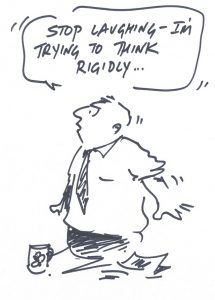Why Innovation can be so difficult …
Don’t be alarmed, but if you are like me and most people on the planet … You are not that rational.
Like it or not, we are emotional beings plagued with conscious and unconscious biases with which we make “emotional” decisions. While we do this, innovating can be tough going.
We continue to get away with this because we have a very deceptive brain that does some fancy reverse-engineering to justify our emotional decision-making. Our responses are based upon our own unique patterns of knowledge and past experience and these are the primary filters through which we view and react with the world. When we see the world through the same old lenses, innovating can be an uphill battle.
In his book “Brain and Culture” Professor Bruce Wexler wrote … “During the first part of life, the brain and mind are highly plastic, require sensory input to grow and develop and to shape themselves to the major recurring features of their environment. By early adulthood the mind and brain have a diminished ability to change those structures …. much of the brain’s activity is devoted to making the environment conform to the established structures”. In other words, during early life the world shapes what we see, but from then on our brains shape what we see! It’s an astounding concept, yet one that makes perfect sense, at least partially explaining our often entrenched and intractable views.
There is no need to wonder why the adoption of new ideas and driving innovation can be problematic.
Our adult brain is regularly presented with views that are counter to what it “knows” and is often reluctant to adjust to incorporate these views. Instead of rearranging itself to better reflect the truth, it can go to great lengths to distort, deny, disregard or rationalise.
It’s little wonder that so many change initiatives fail, and even less surprising that organisational uptake of new innovative approaches can be so sluggish.
I often use the well worn adage in strategy work that “You cannot tell anyone anything”. You cannot make up a person’s mind for them – they must do this themselves. So the key to successful change and the key to the acceptance of new and innovative approaches is simple; Instead of justifying the change (telling them) allow them to see, design and implement the change themselves. The contrast in doing so is stark.
An innovative idea in concept can be very difficult to embrace when it’s not in accordance with our own experience. However, once the idea is put into action and the subsequent value can be seen or experienced first-hand, the innovation be can easily acknowledged. This is to say that innovations are usually acknowledged as such in hindsight. Far less so with foresight. Many of the world’s great innovations were initially rejected when first mooted, and it was only via implementation that the value could be seen. So the key take-away is that ACTION and DOING must be the primary components of any strategy. Perceptions are more likely to change through focused action than any persuasive argument or strategy.
If we can help others change how they see and perceive things, they can then change their own thinking and responses. Therefore a key component of any innovation strategy is finding ways for the rubber to hit the road.
The processes for doing this are elegantly simple, yet too often ignored in favour of our default problem-solving approaches. We rapidly generate solutions based upon our past experiences and fail to stop, think and redefine the problem from multiple perspectives in order to determine the myriad other potential responses. “What served us well in the past will do so into the future”, is not a sound philosophy going forward. We have a strong solution-orientation that uses our existing “knowledge” that can take us down the wrong pathways.
In an environment where we are constantly asked to do more with less, and where an epidemic of “busyness” prevails, new perspectives and new ways of thinking are crucial. To simply continue down the current decision-pathways is a slow and unsustainable death-spiral. We need to help ourselves see things from different perspectives and in doing so, temporarily over-ride our brain’s unique wiring to see and consider new ways forward.
Need help in driving more innovative practice? Give us a call on 0400 109727 or email think.quick@me.com


Comments
No comment yet.